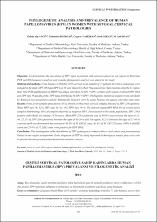| dc.contributor.author | Alp Avcı, Gülçin | |
| dc.contributor.author | Bozdayı, Gülendam | |
| dc.contributor.author | Taşkıran, Çağatay | |
| dc.contributor.author | Özkan, Seçil | |
| dc.contributor.author | Onan, Mehmet Anıl | |
| dc.date.accessioned | 2019-05-13T09:08:40Z | |
| dc.date.available | 2019-05-13T09:08:40Z | |
| dc.date.issued | 2013 | |
| dc.identifier.citation | Alp Avcı, G., Bozdayı, G., Taşkıran, Ç., Özkan, S., Onan, M. A. Phylogenetic analysis and prevalence of human papillomavirus (HPV) in women with several cervical pathologies. Journal of Turkish Society of Obstetrics and Gynecology, 10(3), 151-159. | en_US |
| dc.identifier.issn | 1307-699X | |
| dc.identifier.uri | https://doi.org/10.5505/tjod.2013.03779 | |
| dc.identifier.uri | https://hdl.handle.net/11491/2031 | |
| dc.description.abstract | Objective: To determinate the prevalence of HPV types in patients with cervical cancers in our legion by Real time PCR and DNA sequence analysis and to make phylogenetic analysis was aimed in this study. Material and methods: From January to October 2010, cervical swap samples of 77 patients directed to colposcopy were included in the study. HPV DNA and HPV type 16 were detected by Real Time polymerase chain reaction using the L1 region. Real Time PCR amplifications of MY09/11 products were done by GP5+/GP6+ primers and Cyanine-5 labeled HPV DNA and HPV type 16 specific probe. HPV types determinate by GP5+/GP6+. Phylogenetic analysis of sequences was calculated by Kimura's two parameters method. Statistically analyses were by using Pearson chisquare and odss ratio tests. Results: Forty seven samples (prevalence; 61%) of total seventy seven cervical samples detected as HPV DNA positive. While HPV type 16; 52%, HPV type 16+11; 4%, HPV type 16+6; 1% and non-typing HPV DNA 4% of seventy seven samples determining, 39% of samples observed as negative HPV. Participated in the study population, HPV DNA positive individuals are among 34-56 years. Most HPV DNA positivity rate of 80.0% was between the ages of 31-40. 52.2% of HPV DNA positivity between the ages of 41-50 to fall, but again, 83.3% between the ages of 51-60 to a second peak was determined that increased. 60.0% of 20 ASC-H cases, 63.8% of 36 ASC-US cases, 100% 9 of HSIL cases and 25.0% of 12 LSIL cases were positive for HPV DNA. Conclusion: The investigation of the distribution of HPV genotypes in women with cervical cancer and precancerous lesions in our region is important. Early diagnosis of HPV by using improved technological assays, play a key role to prevent the turn precancerous lesions into invasive cancers. | en_US |
| dc.language.iso | eng | |
| dc.publisher | Turkish Society of Obstetrics and Gynecology | en_US |
| dc.relation.isversionof | 10.5505/tjod.2013.03779 | en_US |
| dc.rights | info:eu-repo/semantics/openAccess | en_US |
| dc.subject | Cancer of Cervix | en_US |
| dc.subject | DNA Sequence Analysis | en_US |
| dc.subject | Human Papillomavirus | en_US |
| dc.subject | Phylogenetic Analysis | en_US |
| dc.subject | Real Time PCR | en_US |
| dc.subject | DNA Dizi Analizi | en_US |
| dc.subject | Filogenetik Analiz | en_US |
| dc.subject | Gerçek Zamanlı PCR | en_US |
| dc.subject | İnsan Papillomavirus | en_US |
| dc.subject | Serviks Kanseri | en_US |
| dc.title | Phylogenetic analysis and prevalence of human papillomavirus (HPV) in women with several cervical pathologies | en_US |
| dc.title.alternative | Çeşitli servikal patolojiye sahip kadınlarda human papillomavirus (HPV) prevalansı ve filogenetik analizi | en_US |
| dc.type | article | en_US |
| dc.relation.journal | Journal of Turkish Society of Obstetrics and Gynecology | en_US |
| dc.department | Hitit Üniversitesi, Fen Edebiyat Fakültesi, Moleküler Biyoloji ve Genetik Bölümü | en_US |
| dc.authorid | 0000-0003-4049-0756 | en_US |
| dc.identifier.volume | 10 | en_US |
| dc.identifier.issue | 3 | en_US |
| dc.identifier.startpage | 151 | en_US |
| dc.identifier.endpage | 159 | en_US |
| dc.relation.publicationcategory | Makale - Uluslararası Hakemli Dergi - Kurum Öğretim Elemanı | en_US |


















